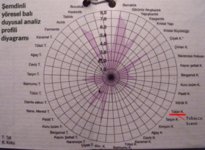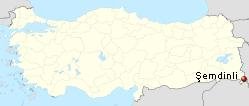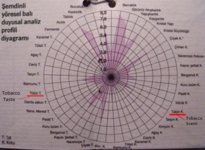Although I'm not a bee keeper, a tobacco related honey really take my attention.
As I recall from last year there was some conversations about tobacco honey. Today I got some local honeys and one of them really made me surprised, “Şemdinli Balı” (Şemdinli Honey).

Şemdinli is the easternmost district of Hakkari province, has borders to both Iraq and Iran.

Because of its rich flora and endemic plants (10 of them are endemic to Şemdinli), especially honey plants, the plateaues/uplands of this region produce special honeys.

A photo from Silo Upland.

Some beehives in a sheltered small valley.

Ters Lale (Fritillaria imperialis)
This bulbous plant is native to cold highlands of Anatolia, especially in Adıyaman and Hakkari but not a honey plant.
Back to topic, there was a small booklet with the honey jar. The “diagram of sensual analysis profile” says that there’s an intense tobacco scent in the honey (approx. 3 of 8 intensity). I don’t know the techniques people use for determining the senses so I might translate the terms wrong.
Here’s the diagram ;

It’s very well known that there was tobacco production in Şemdinli in the past, I don’t know the situation today. There’s an accession on GRIN, PI 494162 – Semdinli. Although the plant photo in the system looks undefinable, Şemdinli is evaluated in Bitlis tobacco group but leaves are more elliptic, wider auricled and thinner textured. It’s reported that Şemdinli is one of the most scented tobaccos in this region. May be there're still some growers there and bees are visiting them frequently.
I tasted the honey, the taste evoked nutty (especially walnut) flavors to me. Well, it really smells like some sweet tobacco (not dominant) mixed with spicy flower scents. I wish you can get this scent too.
As I recall from last year there was some conversations about tobacco honey. Today I got some local honeys and one of them really made me surprised, “Şemdinli Balı” (Şemdinli Honey).

Şemdinli is the easternmost district of Hakkari province, has borders to both Iraq and Iran.
Because of its rich flora and endemic plants (10 of them are endemic to Şemdinli), especially honey plants, the plateaues/uplands of this region produce special honeys.
A photo from Silo Upland.
Some beehives in a sheltered small valley.
Ters Lale (Fritillaria imperialis)
This bulbous plant is native to cold highlands of Anatolia, especially in Adıyaman and Hakkari but not a honey plant.
Back to topic, there was a small booklet with the honey jar. The “diagram of sensual analysis profile” says that there’s an intense tobacco scent in the honey (approx. 3 of 8 intensity). I don’t know the techniques people use for determining the senses so I might translate the terms wrong.
Here’s the diagram ;
It’s very well known that there was tobacco production in Şemdinli in the past, I don’t know the situation today. There’s an accession on GRIN, PI 494162 – Semdinli. Although the plant photo in the system looks undefinable, Şemdinli is evaluated in Bitlis tobacco group but leaves are more elliptic, wider auricled and thinner textured. It’s reported that Şemdinli is one of the most scented tobaccos in this region. May be there're still some growers there and bees are visiting them frequently.
I tasted the honey, the taste evoked nutty (especially walnut) flavors to me. Well, it really smells like some sweet tobacco (not dominant) mixed with spicy flower scents. I wish you can get this scent too.
Attachments
Last edited:







